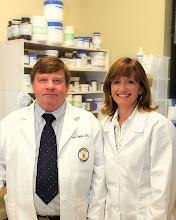Hydroxy acids are used extensively in anti-aging products for their ability to decrease the appearance of fine lines and wrinkles and to improve skin texture. There are two types of hydroxy acids -alpha and beta. Glycolic acid, derived from sugar cane, is the smallest and the most widely recognized alpha hydroxy acid (AHA), but there are several others that are used. These include lactic acid which is derived from milk and is also a natural component of skin, malic acid which is derived from almonds, tataric acid which is derived from grapes, and citric acid which is derived from oranges and lemons. AHA's have been used for thousands of years to rejuvenate the skin. Cleopatra supposedly bathed in sour milk (lactic acid) to improve her complexion. There is only one beta hydroxy acid (BHA) and that is salicylic acid which is derived from the bark of a willow tree.
The main difference in beta hydroxy acids and alpha hydroxy acids is their skin permeability. Alpha hydroxy acids are water soluble and beta hydroxy acids are lipid (oil) soluble. This means that beta hydroxy acids are able to penetrate oil filled pores which contain sebum and exfoliate the dead skin cells that are built up in the pore. Alpha hydroxy acids are primarily used on thickened, sun-damaged skin where breakouts are less likely. Beta hydroxy acids are commonly used in acne preparations in concentrations of 1 to 2 percent. Salicylic acid is a large molecule so it needs to be absorbed in order to be effective so cleansers containing salicylic acid are not very effective.
AHA's are used for their exfoliating properties by dissolving the bond that holds the damaged upper layers of the skin allowing the release of the dead skin cells resulting in an improved skin texture and a reduction in fine lines and wrinkles. This is a normal process of the skin, known as desquamation, but as we age this cell turnover becomes uneven and even slows down making the skin look dull and uneven increasing the thickness of the stratum corneum or top layer of skin. To keep these skin cells in a constant state of motion, we need to exfoliate on a regular basis. This allows the skin to maintain a healthy, younger look by placing the new cells on the outermost layer of skin. Several months of continual use are needed to see visible results. There are several strengths of AHA's that are used, but only strengths up to 10% are found in consumer products. Strengths as high as 30% are used as peels in a professional setting and these agents rapidly thin the stratum corneum. Peels go deeper into the skin beneath the epidermis into the dermis which creates a more rapid level of new cell growth. Salicylic acid peels are also available typically in concentrations of 20 to 30%.
AHA's are not without their side effects. These side effects include burning, itching, reddening, pain, and possibly scarring. Even though these products decrease the signs of photo aging, they paradoxically increase the skin's sensitivity to the sun requiring the use of a sunscreen containing both UVA and UVB protection. The pH of AHA's is required by the FDA to be at least 3.5 or higher decreasing the stinging effect somewhat even though these products due tend to sting upon application. Beta hydroxy acid (salicylic acid) is a derivative of aspirin making it less irritating than alpha hydroxy acids because salicylic acid retains some of the anti-inflammatory properties of aspirin. Salicylic acid can still cause skin irritation and because it is a derivative of aspirin it should not be used by pregnant or lactating women or those that are allergic to aspirin. Consumers with sensitive skin that cannot tolerate AHA's may find they can use salicylic acid products with good results; although, AHA's penetrate the skin deeper producing better anti-aging results. A product containing an AHA or BHA should be part of your daily skincare regimen to promote exfoliation producing skin with a fresh youthful look.
Thursday, August 20, 2009
Alpha and Beta Hydroxy Acids - Their Benefits in Skincare Products
Subscribe to:
Post Comments (Atom)


No comments:
Post a Comment